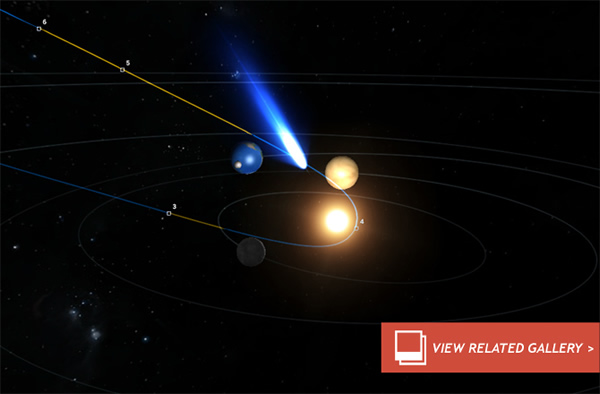Fly With ISON In Stunning Comet Simulation
If you haven’t heard about Comet ISON by now, welcome back! You’ve likely been in hibernation for the most part of a year. Fortunately for you, the world has gone ISON crazy, especially now the potential “Comet of the Century” has brightened and become a naked-eye object. Also, this great cometary encounter has spawned some awesome visualization tools, notably the “Comet ISON 2013″ interactive model created by the INOVE team.
As an astrophysicist, I might know how comets work; but as a novice astronomer, I don’t always know where to look to find them. And ISON is no exception. But fortunately for me, this visualization of ISON flying through the inner solar system will help as the comet becomes brighter. My bet is that the “dirty snowball” will survive its close encounter with the sun on Nov. 28 and emerge from the other side, giving the citizens of Earth a ringside view of a beautiful and historic celestial event. (Unless the comet becomes solar chum and breaks up after perihelion, still a pretty cool event!)
The INOVE real time simulation has plotted ISON’s path past Mars, Earth, Venus and Mercury, animating the motion of the planets as the comet makes its death-defying plunge into the solar corona. By switching the view from space to the view we have from Earth, you can use the handy tracker bar along the bottom of the simulation to see which constellation the comet is currently passing through. By automatically detecting where you are located, the model adjusts to your view of the night sky and reveals its location night-by-night.
Although the visualization has a web-based application, there’s also a useful downloadable desktop version that uses the Adobe AIR run-time system. Regardless of installation, both versions run smoothly and provide an excellent insight to the comet’s journey.
In short, the Comet ISON Model is a superb tool for tracking Comet ISON and a beautiful interactive animation that will keep you entertained while ISON remains a solar system visitor.
Comet ISON, cataloged as C/2012 S1, was discovered in September 2012 by the International Scientific Optical Network in Russia. It immediately caused a stir as astronomers realized it was a “new comet” making its first appearance into the solar system after dropping out of the Oort Cloud, a hypothesized “comet reservoir” that surrounds the solar system approximately one light-year distant.(Nov 19, 2013 12:31 PM ET // by Ian O'Neill)












